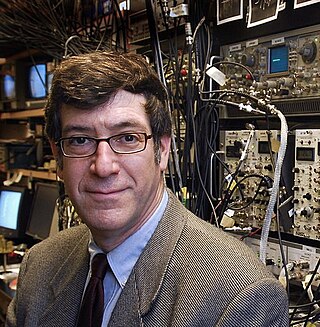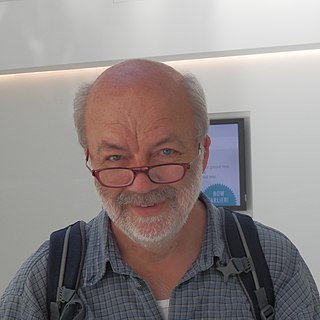Related Research Articles
A photon is an elementary particle that is a quantum of the electromagnetic field, including electromagnetic radiation such as light and radio waves, and the force carrier for the electromagnetic force. Photons are massless particles that always move at the speed of light measured in vacuum. The photon belongs to the class of boson particles.

Satyendra Nath Bose was an Indian theoretical physicist and mathematician. He is best known for his work on quantum mechanics in the early 1920s, in developing the foundation for Bose–Einstein statistics and the theory of the Bose–Einstein condensate. A Fellow of the Royal Society, he was awarded India's second highest civilian award, the Padma Vibhushan, in 1954 by the Government of India.

Sir Michael Victor Berry is a British theoretical physicist. He is the Melville Wills Professor of Physics (Emeritus) at the University of Bristol.

Artur Konrad Ekert is a British-Polish professor of quantum physics at the Mathematical Institute, University of Oxford, professorial fellow in quantum physics and cryptography at Merton College, Oxford, Lee Kong Chian Centennial Professor at the National University of Singapore and the founding director of the Centre for Quantum Technologies (CQT). His research interests extend over most aspects of information processing in quantum-mechanical systems, with a focus on quantum communication and quantum computation. He is best known as one of the pioneers of quantum cryptography.

John Clive Ward, was an Anglo-Australian physicist who made significant contributions to quantum field theory, condensed-matter physics, and statistical mechanics. Andrei Sakharov called Ward one of the titans of quantum electrodynamics.

Roy Jay Glauber was an American theoretical physicist. He was the Mallinckrodt Professor of Physics at Harvard University and Adjunct Professor of Optical Sciences at the University of Arizona. Born in New York City, he was awarded one half of the 2005 Nobel Prize in Physics "for his contribution to the quantum theory of optical coherence", with the other half shared by John L. Hall and Theodor W. Hänsch. In this work, published in 1963, he created a model for photodetection and explained the fundamental characteristics of different types of light, such as laser light and light from light bulbs. His theories are widely used in the field of quantum optics. In statistical physics he pioneered the study of the dynamics of first-order phase transitions, since he first defined and investigated the stochastic dynamics of an Ising model in a paper published in 1963. He served on the National Advisory Board of the Center for Arms Control and Non-Proliferation, the research arms of Council for a Livable World.

Daniel Frank Walls FRS was a New Zealand theoretical physicist specialising in quantum optics.

Robin K. Bullough was a British mathematical physicist known for his contributions to the theory of solitons, in particular for his role in the development of the theory of the optical soliton, now commonly used, for example, in the theory of trans-oceanic optical fibre communication theory, but first recognised in Bullough's work on ultra-short optical pulses. He is also known for deriving exact solutions to the nonlinear equations describing these solitons and for associated work on integrable systems, infinite-dimensional Hamiltonian systems, and the statistical mechanics for these systems. Bullough also contributed to nonlinear mathematical physics, including Bose–Einstein condensation in magnetic traps.

Mark George Raizen is an American physicist who conducts experiments on quantum optics and atom optics.
Tai Tsun Wu was a Chinese-born American physicist and writer well known for his contributions to high-energy nuclear physics and statistical mechanics. He was married to famed experimental physicist Sau Lan Wu.
John Lawrence CardyFRS is a British–American theoretical physicist. He is best known for his work in theoretical condensed matter physics and statistical mechanics, and in particular for research on critical phenomena and two-dimensional conformal field theory.

Robert William Boyd is an American physicist noted for his work in optical physics and especially in nonlinear optics. He is currently the Canada Excellence Research Chair Laureate in Quantum Nonlinear Optics based at the University of Ottawa, professor of physics cross-appointed to the school of electrical engineering and computer science at the University of Ottawa, and professor of optics and professor of physics at the University of Rochester.
Edward Roy Pike FRS is an Australian physicist, specializing in quantum optics.
Mikhail Lukin ; born 10 October 1971) is a Russian theoretical and experimental physicist and a professor at Harvard University. He was elected a member of the National Academy of Sciences in 2018.
Peter Nicholas Pusey is a British physicist. He is an Emeritus Professor of Physics at the School of Physics and Astronomy of the University of Edinburgh.

Yasunobu Nakamura (中村 泰信 Nakamura Yasunobu) is a Japanese physicist. He is a professor at the University of Tokyo's Research Center for Advanced Science and Technology (RCAST) and the Principal Investigator of the Superconducting Quantum Electronics Research Group (SQERG) at the Center for Emergent Matter Science (CEMS) within RIKEN. He has contributed primarily to the area of quantum information science, particularly in superconducting quantum computing and hybrid quantum systems.

Howard John Carmichael is a British-born New Zealand theoretical physicist specialising in quantum optics and the theory of open quantum systems. He is the Dan Walls Professor of Physics at the University of Auckland and a principal investigator of the Dodd-Walls Centre. Carmichael has played a role in the development of the field of quantum optics and is particularly known for his Quantum Trajectory Theory (QTT) which offers a more detailed view of quantum behaviour by making predictions of single events happening to individual quantum systems. Carmichael works with experimental groups around the world to apply QTT to experiments on single quantum systems, including those contributing to the development of quantum computers. He is a Fellow of Optical Society of America, the American Physical Society and the Royal Society of New Zealand. He was awarded the Max Born Award in 2003, the Humboldt Research Award in 1997 and the Dan Walls Medal of the New Zealand Institute of Physics in 2017. In 2015, he was recognised as an Outstanding Referee by the American Physical Society.

The University College of Science, Technology and Agriculture are two of five main campuses of the University of Calcutta (CU). The college served as the cradle of Indian sciences by winning the Nobel Prize in Physics in 1930 and many fellowships of the Royal Society London.
Alexander Luis Gaeta is an American physicist and the David M. Rickey Professor of Applied Physics at Columbia University. He is known for his work on quantum and nonlinear photonics. He is a Fellow of the American Physical Society, Optica, and of the Institute of Electrical and Electronics Engineers.

Gerhard "Gerd" Leuchs is a German experimental physicist in optics. He is the Director Emeritus at the Max Planck Institute for the Science of Light and an adjunct professor in the physics department at the University of Ottawa. From 1994-2019 he was a full professor of physics and since 2019 has been a senior professor at Friedrich-Alexander University Erlangen-Nürnberg (FAU).
References
- 1 2 3 "Jakeman, Eric" . Who's Who . Vol. 2016 (online Oxford University Press ed.). Oxford: A & C Black.(Subscription or UK public library membership required.)
- 1 2 3 Jakeman, E (2006). Modeling fluctuations in scattered waves. Boca Raton, Florida: CRC Press. ISBN 0-7503-1005-7.
- 1 2 Physics, Institute of. "Maxwell medal recipients". Institute of Physics - For physics • For physicists • For all. Retrieved 6 July 2017.
- 1 2 3 4 5 "Physics Community News". Physics World. 7 (10). IOP Publishing: 57–66. 1994. doi:10.1088/2058-7058/7/10/35. ISSN 0953-8585.
- ↑ "Eric Jakeman". London: Royal Society. One or more of the preceding sentences may incorporate text from the royalsociety.org website where "all text published under the heading 'Biography' on Fellow profile pages is available under Creative Commons Attribution 4.0 International License."
- ↑ "EC/1990/17: Jakeman, Eric". The Royal Society . Retrieved 6 July 2017.